A Classical Horseback Riding Vacation in Tuscany
Fall in love with the art of dressage on this peaceful and relaxing holiday in Italy where you will also hone your riding skills.
by Jec Aristotle Ballou
It feels like the type of riding that will continue to improve at once your commitment, your skills, and maybe even your heart long after leaving. The passion here in these Tuscan hills is infectious. Right as I lift my eyes to the surrounding golden countryside, Giovanni De Marchi coaches me through a walk to canter transition with the enthusiasm of someone still very much in love with the art of dressage even after decades of teaching riders from around the globe, roughly 10,000 at last tally. Of course, with the good life, la dolce vita, so close at hand in this region of Chianti, it might be impossible not to cultivate the same joyful approach to training, or life in general, on a daily basis.

This state of being, one of deep peaceful relaxation along with inspired motivation, permeates not only the riding lessons here at Il Paretaio Classical Riding Center in Barberino, twenty miles outside Florence. During their weeklong stays here, students find new feelings for everything from sitting trot to half-pass to the type of mindfulness and contentment that makes us all better humans for our horses. While the satiety of the good life might not be what led me here initially, it quickly became evident it leads to better riding.
During one morning lesson aboard Tempo, an agile Lusitano gelding, Giovanni’s wife Cristina offered the advice, half-kidding, that after a few more weeks of enjoying elaborate Italian dinners and the leisurely pace of each day my half-halts would become more effective. By that, she meant I would be melting down in the saddle, remaining firm—but at ease—with my posture. In fact, a frequent prompt during lessons, which are conducted in multiple languages, is for riders to find “calm energy” in their bodies.
The History of Dressage in Italy
To its credit, Italy played a major role in the development of modern dressage. In 1532, Federico Grisone opened the world’s first modern riding school in Naples with teachings based on Xenophon’s early treatise of dressage from 350 B.C. At that time, a good riding education was considered to be a requirement for young gentlemen to be successful in a courtly society. Grisone was joined by two other Italian riding masters, Giambattista Pignatelli and Caesar Fiaschi, who steered dressage on its evolution towards the sport we know today by writing down many of their methods in materials that were distributed and studied. Pignatelli’s student Antoine de Pluvinel was commissioned by the French Court to establish a riding school in France similar to the venerated Naples school. Eventually, similar schools sprung up throughout Europe, including the famous Spanish Riding School in Vienna.
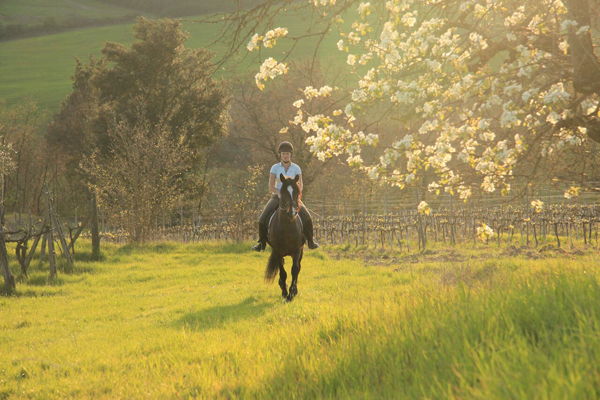
The De Marchis, prior to committing themselves to creating their own classical riding center, both fell in love with horses early on. Their formative years were spent under the tutelage of students of Nuno Oliveira’s. They also studied and trained for many years at the National Stud in Portugal. Along the way, they have also immersed themselves in other traditions of training that feel symbiotic with their classical roots, like Centered Riding, and some of the Natural Horsemanship principles. Over the last twenty years of operation in Tuscany, they have increased their school’s international reputation, but have altered none of their commitment to the training principles of antiquity along the way.
Horseback Riding at Il Paretaio: What to Expect
Il Paretaio feels like a pilgrimage for riders who have steeped themselves in classical dressage. Il Paretaio has several young instructors and over twenty high quality school horses, though, it also caters to new or novice riders in addition to advanced dressage students. Lessons run throughout the day beginning at 7:30am with a large pause in the middle to reprieve from the heat.
.jpg)
Students ride together in small groups of two to three or can opt for a private lesson when the schedule allows. Each 50-minute lesson follows the progression riders envision of a classical European school, complete with castle views from the arena. Throughout, riders remain mostly in single file formation, which puts riders in a constant state of adjusting their horse’s rhythm, another reminder of staying firmly rooted in every moment.
Students spend ample time in the beginning of each lesson loosening their horses by riding figures and lateral work in a lively but relaxed walk. This phase of “connecting the horse’s body to your seat and his mind to your mind,” as Giovanni explained it, sets the stage for any training session to be productive. In the walk, explains Cristina, considerable learning and progress happens for both horse and rider, but too many riders skip over it in their daily work. When they are too eager to get to the faster movements, they often skip the finer points of dressage. At Il Paretaio, students learn the value of that initial walk period, especially for touring through lateral movements and feeling every stride.
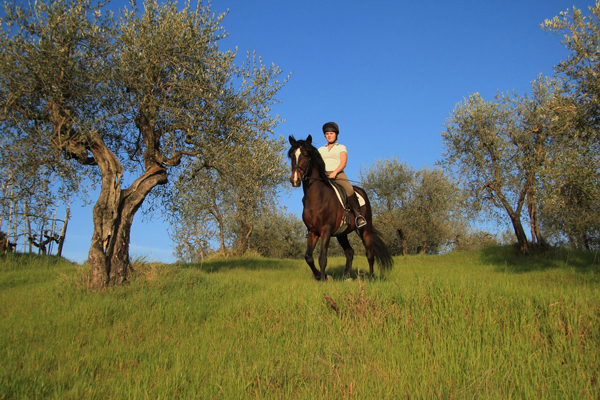
For the first several minutes of my private lesson, Giovanni asked me to walk Squibb, a grey Andalusian cross, briskly on a long rein to loosen Squibb’s body and also to use the bending aids of my seat and leave my hands quiet. When the rhythm became regular and swinging, we progressed to riding Squibb more into the contact and then progressed to lateral movements along the quarter lines ensuring that I cued him—minimally—from my core and not by over-using leg pressure. A lively round of posting trot followed, continuing to utilize arena figures and lateral exercises when Squibb’s posture or engagement needed improvement. To maintain good swing and looseness in the horses’ backs, most trotting work at Il Paretaio is done in posting trot, he explained, including shoulder-in and haunches-in. He believes that many riders make themselves and their horses stiff by over-using the sitting trot. He prefers to see riders use the sitting trot for brief periods throughout each session when the movement is relaxed and engaged. On this note, all of Il Paretaio’s instructors emphasize how and why to ride exercises so that, even with extensive dressage schooling, horses do not become robotic or dull.
Instructors show riders how to modify certain lines of travel and tempo during exercises to retain each horse’s freshness, to keep him alert and responsive. During my canter transitions aboard Tempo, for instance, Giovanni asked me to ride down the center of a 20-meter circle straight towards C and then, right before the rail, execute a canter depart and then turn immediately in the new direction. This exercise keeps both horses and riders sharp and quick. Again, he prompted me during the exercise to cue for the canter more from a slight hip movement and to use very little leg pressure. Cuing from the hip helped the horse move smoother into the canter, Gianni said, and prevented the leg from becoming dull.
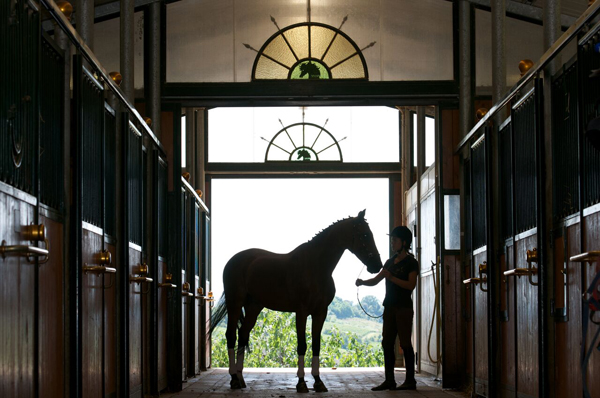
Later in the evening, we are able to expand on some of these philosophies and the classical tenets that Il Paretaio preserves. Seated around the massive dining room table with the sun long disappeared, students relaxed for bountiful and leisurely Tuscan dinners with free-flowing wine from the local Chianti region. Giovanni and Cristina, along with their son Pietro happily shared their love and wisdom of training horses and riders. Above all, lightness of a rider’s aids and harmony with her horse remain uncompromised foundations here. If sometimes their passion makes them sound like guardians of classical dressage, it is because this part of the world just might be.
Most nights at Il Paretario, ten to twenty students gather for dinner, coming from all over the globe and joined by the common bond of horses. During our week at Il Paretaio, we shared arena time and meals with couples from Germany, China, a few families from France, and Belgium. As we cleaned every morsel of Tirimasu from our plates, we shared stories of home and talked in the language that united us: horses. From overhead shelves bordering the dining room, Cristina’s collection of more than four hundred horse figurines arched their wooden and plastic necks over our lively conversations patching together accented English.
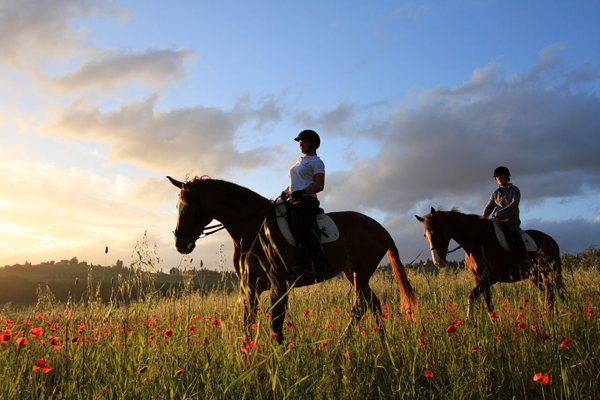
During dinner, the following day’s riding schedule and horse assignments appeared on the mantle. Before lifting their post-dinner espressos, riders excitedly rushed over to see the schedule, trading notes with each other about various horses or commiserating for those assigned to the lower arena requiring a long downhill trek over cobblestones. This impressive daily spreadsheet logged the rotation of 20 guests, five instructors, nearly 30 horses, and two arenas. Impressively, everything ran like clockwork. Promptly at designated lesson times, every horse is prepared and saddled by the school’s staff of grooms, some of who were previous visitors to the school and have come back to stay for good.
On our final afternoon at the school, we headed out through the countryside for a two-hour ride to the private wine cellar of Riccardo Casamonti. We rode through slanting afternoon sun washing over butter colored hillsides, clip-clopped through the cobbled piazza of ancient stone villages, and meandered through verdant wine farmsteads. After tethering our horses on a high tie outside Casamonti’s cellar, we went inside for a personalized, and bountiful, education and tasting of traditional Chianti wines. As our horses nibbled grass nearby, we snacked on homemade olive oil drizzled over flatbread and learned about the evolution of well-known wines like Chianti Classico. Tasting the exquisite flavors of Casamonti’s three different red wines, we detected characteristics that might only be described as passion, or commitment to history.

Traveling home on horseback, the hills glowing in late golden light, we nearly lost track of what century we were in. And if 20 years of successful operation at Il Paretaio are any indication, this state of being serves us all well. Lulled by the rhythmic walk underneath me and the on-coming twilight, I grew reflective. It occurred to me how this trip to Italy, as with most experiences involving horses, had steered way off my projected course and yet arrived at a sublime outcome nonetheless.
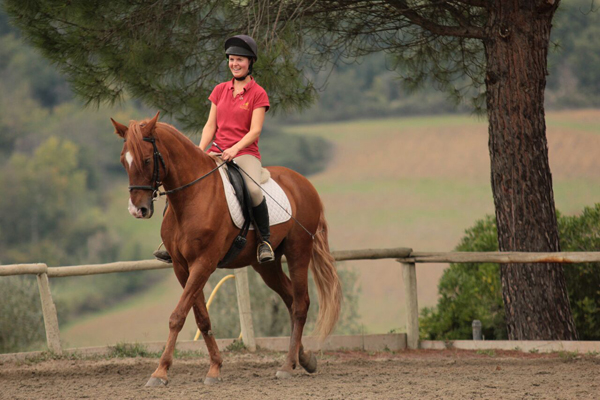
I had arrived at this classical riding school intending to dissect and hone the minutia of dressage aids. Or at least that was what I thought I needed. Turns out, I needed the kind of revamp to my riding that comes in the form of improving oneself from the inside out, taking time to settle down and breathe. With quiet elegance, life at Il Paretaio improves riders in ways they did not anticipate, ways they will quickly fall in love with. This just might explain how classical dressage has survived so long.
About the author: Jec A. Ballou so thoroughly enjoyed her time in Italy that she is leading a group of students there in November 2016. The author of three books, including 101 Dressage Exercises for Horse and Rider, she is based in Santa Cruz, CA and teaches nationwide. Her web site is www.JecBallou.com.




